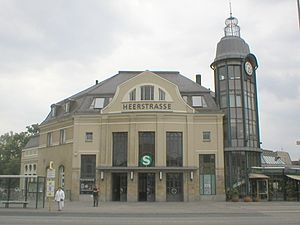Spandau Suburban Line
| Spandau Suburban Line | |||||||||||||||||||||||||||||||||||||||||||||||||||||||||||||||||||||||||||||||||||||||||||||||||||||||||||||||||||||||||||||||||||||||||||||
|---|---|---|---|---|---|---|---|---|---|---|---|---|---|---|---|---|---|---|---|---|---|---|---|---|---|---|---|---|---|---|---|---|---|---|---|---|---|---|---|---|---|---|---|---|---|---|---|---|---|---|---|---|---|---|---|---|---|---|---|---|---|---|---|---|---|---|---|---|---|---|---|---|---|---|---|---|---|---|---|---|---|---|---|---|---|---|---|---|---|---|---|---|---|---|---|---|---|---|---|---|---|---|---|---|---|---|---|---|---|---|---|---|---|---|---|---|---|---|---|---|---|---|---|---|---|---|---|---|---|---|---|---|---|---|---|---|---|---|---|---|---|

Heerstraße station on the suburban line
|
|||||||||||||||||||||||||||||||||||||||||||||||||||||||||||||||||||||||||||||||||||||||||||||||||||||||||||||||||||||||||||||||||||||||||||||
| Overview | |||||||||||||||||||||||||||||||||||||||||||||||||||||||||||||||||||||||||||||||||||||||||||||||||||||||||||||||||||||||||||||||||||||||||||||
| Locale | Berlin, Germany | ||||||||||||||||||||||||||||||||||||||||||||||||||||||||||||||||||||||||||||||||||||||||||||||||||||||||||||||||||||||||||||||||||||||||||||
| Line number | 6025 | ||||||||||||||||||||||||||||||||||||||||||||||||||||||||||||||||||||||||||||||||||||||||||||||||||||||||||||||||||||||||||||||||||||||||||||
| Technical | |||||||||||||||||||||||||||||||||||||||||||||||||||||||||||||||||||||||||||||||||||||||||||||||||||||||||||||||||||||||||||||||||||||||||||||
| Line length | 8.8 km (5.5 mi) | ||||||||||||||||||||||||||||||||||||||||||||||||||||||||||||||||||||||||||||||||||||||||||||||||||||||||||||||||||||||||||||||||||||||||||||
| Track gauge | 1,435 mm (4 ft 8 1⁄2 in) standard gauge | ||||||||||||||||||||||||||||||||||||||||||||||||||||||||||||||||||||||||||||||||||||||||||||||||||||||||||||||||||||||||||||||||||||||||||||
| Electrification | 750 V DC third rail | ||||||||||||||||||||||||||||||||||||||||||||||||||||||||||||||||||||||||||||||||||||||||||||||||||||||||||||||||||||||||||||||||||||||||||||
| Route number | 200.75, 200.9 | ||||||||||||||||||||||||||||||||||||||||||||||||||||||||||||||||||||||||||||||||||||||||||||||||||||||||||||||||||||||||||||||||||||||||||||
|
|||||||||||||||||||||||||||||||||||||||||||||||||||||||||||||||||||||||||||||||||||||||||||||||||||||||||||||||||||||||||||||||||||||||||||||
The Spandau suburban railway (German: Spandauer Vorortbahn) is a suburban railway in Berlin. It is an extension of the Stadtbahn (city railway) from Westkreuz to Spandau. Its last kilometre runs parallel with the Lehrte and Hamburg lines. It is currently used by Berlin S-Bahn line S5.
A new line was built between 1907 and 1911 on the northern edge of the Grunewald forest for suburban services to Spandau and new housing developments. At Heerstraße station, it branches off the line built in 1882 connecting the Berlin-Hamburg railway with the cross-city railway "Stadtbahn" via the Charlottenburg station, and then runs in a cutting to the west. About a kilometre beyond Heerstraße station the new Rennbahn (racetrack) station was built. Like other stations built for special event services at that time, it was generously provided with a terminal station with eight platforms on one side of the line. Its through station had another two platforms. From there the line runs on to the Pichelsberg station The line then makes a wide curve to the north and goes on an embankment. It continues to the north between the nature reserves of Tiefwerder Wiesen and Murellenberge, Murellenschlucht and Schanzenwald to reach the Hamburg and Lehrte lines, where it turns west.
The 1916 Olympic Games were awarded in Berlin and the Deutsche Stadion (German Stadium) was built for the games next to the Grunewald racetrack. Rennbahn station was renamed Stadion (Stadium) in 1913. As a result of World War I the games were cancelled.
...
Wikipedia
